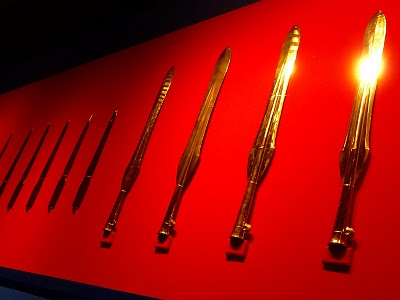Japan in the First Century
In 1983 old clay vessels were found in a hill in Izumo City, Japan.
The clay vessels were believed to be created between the third century and the seventh century, namely the tumulus period in Japan when great kings (later called emperors), kings, chiefs and powerful local families built huge tumulus as their graves. This era is unique in the Japanese history as it clearly showed northern Asian cultural traits (probably because the climate was cold). So, full excavation was conducted in the next two years to discover 358 bronze swords, 6 bronze bell-shaped vessels, and 16 bronze pikes. Especially, the number of the bronze swords was staggering as it surpassed the total of bronze swords that had been previously excavated in Japan as archaeological relics. This discovery changed history of Japan literally.
But when were those relics made?
It is now believed that they were cast in the second or the first century BC.
When were they buried apparently for some ritual?
It is now believed that they were put and set in the ground in the latter half of the first century of the Christian era.
So, those bronze relics of the old Japan or Japan before establishment of the imperial authority, in historical context but not according to the myth, were used for some mysterious ritual and consigned to the ground almost at the same period when the Christian Gospels were written.
Ancient Japanese did not write a history but left such a monument in the slope of a humble hill in Izumo facing the Sea of Japan.
http://inoues.net/ruins/koujin.html
http://inoues.net/ruins/koujin.html
http://inoues.net/ruins/koujin.html
But still an enigma remains as to why they happened to be discovered around 1985.
What happened in 1985?
http://www.yoshinogari.jp/contents5/detail.php?id=143&latest_flg=1
http://www.yoshinogari.jp/contents5/detail.php?id=143&latest_flg=1
http://jp.bloguru.com/kai/query/?pg=18
*** *** *** ***
The hill where so many bronze relics were discovered is called Koiin-Dani. Dani is another form of Tani which means a valley in Japanese. Indeed down a slope of a hill is a kind of valley. But, Kojin is a name of a god which is regraded as a wild and miracle-working spirit, yet sometimes evil. Or Kojin is otherwise regraded as a spirit that protects a house or a man behind the scene.
Indeed the hill Kojin-Dani protected those great relics for 2000 years like the Vatican did for Gospels.
Joh 2:23 Now when he was in Jerusalem at the passover, in the feast day, many believed in his name, when they saw the miracles which he did.
Joh 2:24 But Jesus did not commit himself unto them, because he knew all men,
Joh 2:25 And needed not that any should testify of man: for he knew what was in man.







